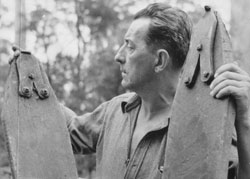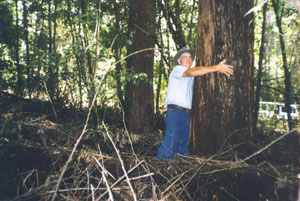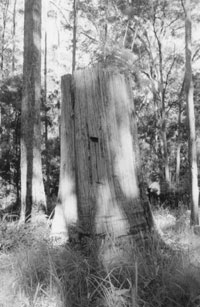|
TimberBy 1856 ships were calling in to the Camden Haven specifically to pick up Red Cedar (then Toona australis now Toona ciliata). They dumped their ballast of Sydney sandstone before proceeding upriver to present-day Kendall where the first organised timber milling took place as early as the 1860s. Cedar was prized by many for its beauty but its ease of working meant that its use became indiscriminate. Whole houses were built of it, public buildings, fine furniture, packing cases, paling fences, farm buildings. There was so much of it that it could be used as deal. The cedar getters developed a special technique. Crosscut saw, axe, standing boards were their only equipment. Cedars are buttressed, the bases are often hollow, so they felled them at heights up to six metres off the ground. They would cut a slot about shoulder height – they called it a scaffold hold – drive in a board, stand on it, cut the next slot and drive in another board, perhaps another and another. Since boards were awkward to carry through the bush, many used one board only. After they had cut the second slot they would cut a toe hold to stand in while they moved the board up. Getting down as the tree was beginning to fall required great dexterity. In the latter part of the nineteenth century attention turned to the valuable hardwoods of the area and, with occasional exceptions, the last of the great cedar trees remained in their hidden gullies and gorges. The New South Wales Government, aware that the superb softwoods had been almost completely cut out, was anxious not to have this repeated with the excellent hardwoods. From 1883, Crown Land in the Port Macquarie district was 'set aside from sale for preservation and growth of timber’. Forest Reserves were established in 1892 and, in 1907, a Royal Commission of Enquiry into Forests was set up. The enquiry took local evidence during which Robert Longworth reported that his Laurieton mill had a weekly output of 75,000 feet [225 cubic metres] of sawn timber, mostly ‘Blackbutt, Tallow-wood, Brush Box, and several species of gum, including grey gum’, drawn from areas around Kendall. Most of it was exported to England, America and Germany. As a result of the Royal Commission, the 1909 Forestry Act was passed to endeavour to ensure a sustainable supply. Wherever they were accessible, the very big trees were taken out first. Boards rammed into slots were used there too, shod boards were used for extra security.
Following the Second World War, management of native forests was driven for the next two decades by the material demands of a building boom and post-war expansion. Extensive new areas were dedicated to State forest tenure and large areas of forest were opened up to intensive logging and management for the first time. In the 1950s and 60s, it was realised that Australian native forest resources were insufficient to sustain the increasing rate of cut indefinitely. Furthermore, the rate of timber importation was of concern. In 1976 NSW native forests were covered by the Forestry Commission's landmark Indigenous Forest Policy in 1976, which recognised that the best and most accessible of the State's native forests would be managed on a carefully controlled sustainable basis. Kendall Management Area became a showcase of this approach. Since then, many pieces of legislation have had an impact on forestry practices and timber in the Kendall district, among them Regional Forest Agreements, Environmental Planning & Assessment Act 1979 and the Threatened Species Conservation Act. In 1992, the Commonwealth and States reached a landmark agreement in the National Forest Policy which drove the subsequent Comprehensive Regional Assessments (CRA) and Regional Forest Agreements (RFA).
|
© Kendall Community Centre May 2006



